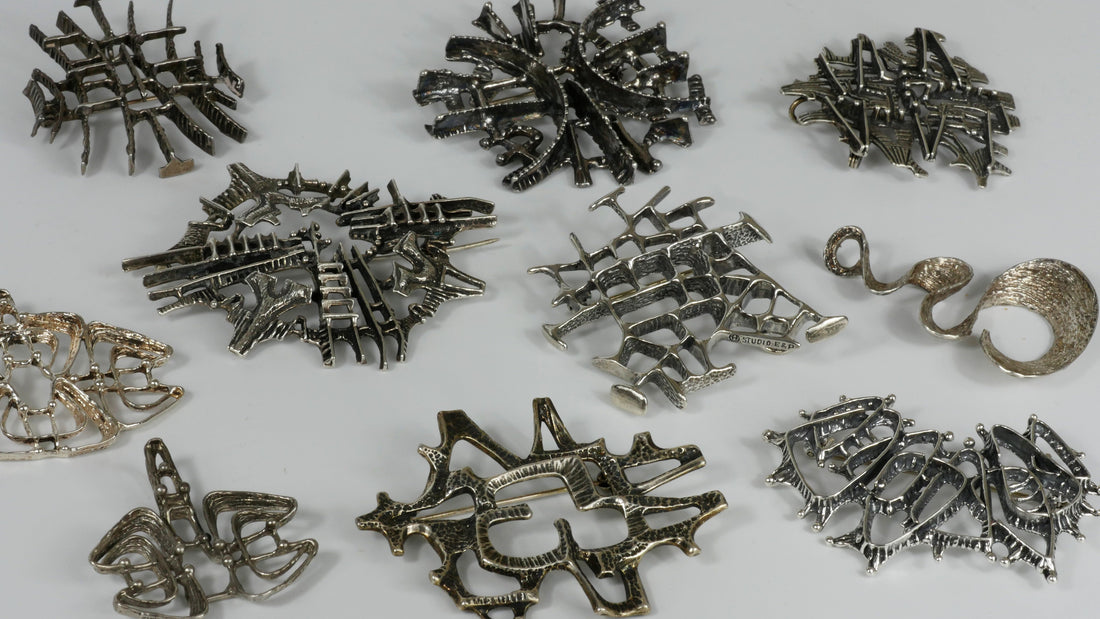
Organic Meets Brutalist: Discovering Studio Else & Paul
Share
This pendant by Studio Else & Paul was one of the first pieces I collected at the beginning of my journey into modernist jewellery. I was captivated by its sculptural form, where organic shapes meet brutalist edges, as if they were always meant to be together. I was also fascinated by the story of Else and Paul: two artists united by a shared creative vision. Together, they were among the trailblazers of the Studio Silver movement, creating hundreds of wearable artworks for thousands to enjoy — especially for those like me who find in vintage pieces a sense of connection with people from another time and place.

For those unfamiliar with Studio Else & Paul, here is a little more about their story and the artistry behind their jewellery.
Breaking Away from Tradition
Else Berntsen Hughes (1938–2002) and Paul Hughes (1934–1981) met while studying silversmithing and goldsmithing in London. From the beginning, they set out to break away from the clean, restrained, almost minimalist lines of Scandinavian design. They were not interested in “polite” jewellery; they sought to create bold forms with presence and depth.
Instead of smooth, predictable surfaces, their work embraced texture, contrast, and sculptural dimension. They explored negative space — the air, cavities, and interstices were treated as deliberately as the metal itself. Their jewellery often appears as a miniature expression of modernist art to be worn on the body.
Organic Meets Brutalist
One of the most striking aspects of Studio Else & Paul’s work is the way it balances opposites. On one hand, their forms are organic: flowing, asymmetrical, almost reminiscent of shapes found in nature. On the other, there is a distinctly brutalist edge: solid weight, strong surfaces, and a raw physicality that gives each piece authority.
This tension — organic and brutalist together — is what gives their jewellery its unique presence. Wearing one of their bangles or pendants feels less like putting on an accessory and more like inhabiting a small work of art.
The Studio Silver Movement
Studio Else & Paul were part of a broader mid-century shift in Norway and Finland known as the Studio Silver movement, which treated jewellery as an art form rather than mere adornment. The movement often drew on abstract sculpture, primitive art, and non-Western traditions.
Else and Paul quickly distinguished themselves through both technical skill and artistic imagination. They frequently used lost-wax casting (à cire perdue), where each model is first sculpted in wax and then cast in metal. This technique allowed them to experiment with form, creating irregular surfaces, subtle undercuts, and sculptural volumes that conventional press-formed jewellery could not achieve.
The result was jewellery that felt alive — tactile, expressive, and unconventional.
International Recognition
The couple’s reputation grew swiftly. In 1960, Studio Else & Paul represented Norway at the Milan Triennale, exhibiting over twenty works. This milestone brought them international recognition.
Through the 1960s and 1970s, their pieces were exported to the USA, Japan, and across Europe. Bronze collections, in particular, achieved commercial success, allowing them to compete with Finnish designers such as Pentti Sarpaneva and Hannu Ikonen. Yet even at the height of their commercial reach, their jewellery retained the sculptural edge that set it apart.
Beyond Jewellery: Sculpture and Table Ornaments
Less well known is that Else and Paul also created small metal sculptures, called “table ornaments.” Exhibited as early as 1959, these pieces often took surreal, modernist forms in silver or bronze. By the later 1960s, their table ornaments became increasingly expressive and experimental, further blurring the line between applied art and fine art.
After Paul’s passing in 1981, Else continued to work and eventually devoted more of her practice to full-scale sculpture. This continuity — from pendant to ornament to sculpture — underscores that their jewellery was never just fashion. It was part of a broader artistic language.
---
Collecting pieces by Studio Else & Paul has been more than a hobby for me — it’s been a way to connect with the artistry and vision of two remarkable designers. Each pendant, brooch or ring carries the story of creative minds who saw jewellery as miniature sculpture. For those who, like me, are drawn to vintage pieces, exploring their work is a journey into mid-century modernist design, where form, texture, and imagination come alive.
